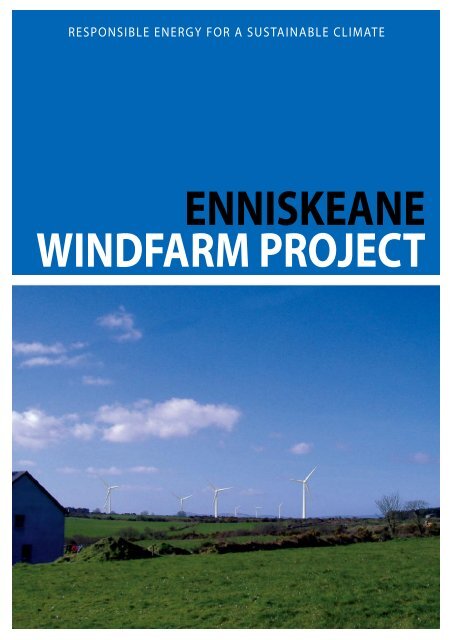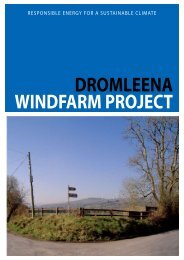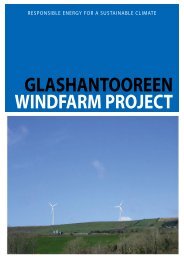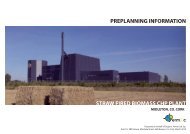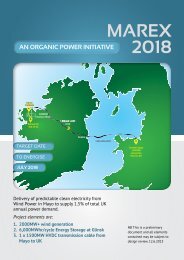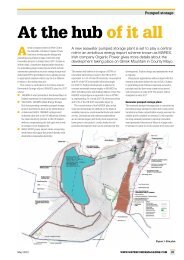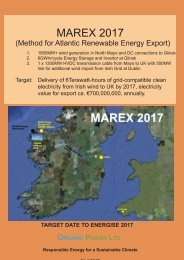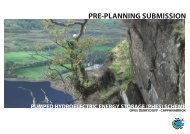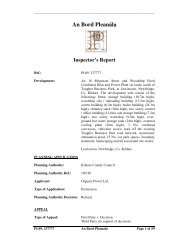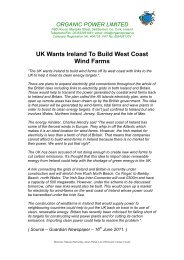ENNISKEANE WINDFARM PROJECT - Organic Power
ENNISKEANE WINDFARM PROJECT - Organic Power
ENNISKEANE WINDFARM PROJECT - Organic Power
- No tags were found...
You also want an ePaper? Increase the reach of your titles
YUMPU automatically turns print PDFs into web optimized ePapers that Google loves.
RESPONSIBLE ENERGY FOR A SUSTAINABLE CLIMATE<strong>ENNISKEANE</strong><strong>WINDFARM</strong> <strong>PROJECT</strong>
ContentsProject Overview 3Project Details 4Why do we need renewable energy 7Meeting the challenge 9Frequently asked questions 11
<strong>PROJECT</strong> OVERVIEWThe proposed €35 million capital cost wind power project at Enniskeane is composedof four clusters, covering the following townlands:Cluster 1; 4 turbines, ShanacloghCluster 2; 3 turbines, Kilnacranaugh East, Belrose Uper, RushfieldCluster 3; 1 turbine, LaravooltaCluster 4; 5 turbines, Courtleigh, FarranthomasThe area proposed for the development is located over lands stretching from north ofCastletown Kinneigh village to Killanear townland, south of Newcestown. Agriculturalland use for all turbine bases will be 2550m 2 , and approximately 3 hectares in total (5.8km long) for access roads and cable ducts. The project will extend over approximately800 Hectares of farmland, consisting mainly of permanent grassland, currently used forsilage and grazing, and lands used for tillage. Less than 2% of this land will be used bywind project infrastructure.The proposed wind farm is being developed by <strong>Organic</strong> <strong>Power</strong> Ltd., a new renewableenergy company based in Skibbereen, Co. Cork. A significant number of shareholdersin this company come from the Enniskeane-Newcestown area. <strong>Organic</strong> <strong>Power</strong> intend todevelop a minimum of 125MW of carbon-free reliable electricity supply from a varietyof renewable energy sources for 2012. This power will be sold to end customers at acompetitive rate.3
<strong>PROJECT</strong> DETAILS<strong>Power</strong>• 14 Enercon wind turbines, 11 each with a maximumgenerating capacity of 2.3MW, plus 3 each with amaximum generating capacity of 0.9MW, totalling28MW installed capacity.• Operating efficiency is projected at 37.5% of installedcapacity, or minimum average output of 10.5MW• Enough energy to power the equivalent of 11,500households• Will result in the avoidance of 62,000 tonnes ofCarbon emissions annually• Will contribute 2.3% of the Government’s target of15% of energy coming from renewable source by2015 (1200MW).Construction• Work is planned to commence around early 2011subject to permits, and will be completed in a workperiod around 9 to 12 months spread over 2 years.• The wind farm has an operational life of 30 years.At the end of its life, the turbines will be dismantledand removed from the site or an application will besubmitted to retain or replace the existing wind turbinesSite SelectionThe wind farm site is regarded as a prime solution due toa combination of the following factors:• High wind speed• Close proximity to available grid capacity• Turbines can be sited in compliance with WindIndustry recommendations and Planning requirementswith respect to noise and other environmental factors• Location of turbines near the existing roadsminimises the impact of construction traffic• Impact on internationally and nationallydesignated sites or landscapes are avoided4
Grid ConnectionGrid capacity is already available and the wind farm will be connected to the national grid at alocation to be determined in consultation with Eirgrid. <strong>Organic</strong> <strong>Power</strong> will undertake to bury allcables required between this location and the turbines. This significantly reduces the potentialenvironmental impacts associated with installation of the grid connection cabling. <strong>Organic</strong><strong>Power</strong> are committed to locating connection cables underground.The design strategy for the Wind Farm is based on the Best Practise Guidelines produced fromthe Irish Wind Industry, Sustainable Energy Ireland, and the Department of the Environment.Wind Farm DesignThe design of the wind farm takes into account the profile and form of the land when viewedfrom the surrounding area. The layout incorporates the relocation or removal of turbines andaccess tracks as well as other components to:• reduce visual impacts from key viewpoints• reduce noise impacts on residential properties• increase distances from watercourse• avoid key habitats of nature conservation interest and areas of archaeological interest• increase distances from bird breeding locations• minimise transport impactsConsent ProcessCork County Council Planning Department will grant or refuse approval for the developmentonce a planning application has been lodged.An Environmental Impact Statement (EIS) accompanies the Planning Application. Thisdocument will be available for public viewing or purchase at Cork County Council andsummaries of reports will be posted on www.organicpower.ie. It will outline the results of aseries of studies that have assessed the potential environmental impacts of the project andwhere possible, have suggested measures to avoid, reduce or minimise these impacts.5
Economic BenefitsThe project will, at its peak, provide in excess of 40 jobs during the construction phase. Theconstruction phase will be nine-twelve months spread over two years. At least 1 full time jobwill be created for the operation of the wind farm, and a further 2 full time or equivalent jobsto undertake the maintenance.Landowners leasing land to the project will receive approximately €200,000 per year from theproject. This is equivalent to the creation of 4 full time jobs in the locality for the duration ofthe wind project. The project will cost up to €35,000,000 to construct, of which, approximately€8,000,000 will be spent on infrastructure including foundations, roads, underground cablingand general building works.It is <strong>Organic</strong> <strong>Power</strong>’s policy to encourage local companies to tender for such work, and itproposes to hold a register of local companies wishing to tender. <strong>Organic</strong> <strong>Power</strong> will liaisewith the local community associations and Business Associations in relation to this. During theoperational phase approximately €390,000 will be spent each year on the general upkeep ofthe wind farm, which will include local employees.<strong>Organic</strong> <strong>Power</strong> is setting up a Community Fund to enable the local community to benefit fromthe operation of the Wind Farm. Approximately €55,000 will be made available each year forfive years for community projects. Door to door survey results indicate that of respondentswant 26% of this money spend on broadband infrastructure, 24% on Sports Clubs, 23% onlocal playgrounds, 22% on local agricultural charities, and 5% on other items.
Why reduce carbon emissions cont.?The following table shows some examples of the relative consequences of stabilising the carbonlevels by reducing emissions now in order to stabilise levels at 450ppm, leading to an IPCCestimated 2.1 degree (range1.9 to 4.4) temperature increase compared to continuing to increaseemissions 750 ppm leading to an IPCC estimated 4.3 degree (range 2.8-6.4) temperature increase:Examples from ‘Six Degrees’ by George Lynas 2007REDUCED EMISSIONSCONTINUED EMISSIONSSea Level 2300 +0.8m +7m Irish coastal cities drownedSummer temperaturehigh Ireland 2100Winter temperature lowIreland 2100Mediterranean holidayspots 2100Gulf Stream 2100Storms Ireland 210030 degrees C 45 degrees CCattle cannot survive in IrelandNo changeLong cold spells below zeroForests burn in summerMuch reduced, Seawatertemperature 10-15 degrees C15% Increase in number andintensityDesert, no waterStopped, Seawater temperaturebelow 6 degrees CRegular severe hurricane stylestorms and floodsFood 2100 Droughts India, China, Africa Worldwide food shortagesClimate Stability 2100 Stable Self-reinforcing increase intemperatureENERGYEnergy is vital to the modern economy. Ireland is over 90% dependent on imported energy andis heavily reliant on imported oil, gas, and coal. Our small indigenous energy supplies continue todecline. A reliance on imported energy may make us more vulnerable to price fluctuations andinterruptions of supply caused by political instability and conflict in other parts of the world.In the first quarter of 2008 crude oil was trading at over $120/barrel, and is forecast by theAssociation for the Study of Peak Oil to trade at €175 in one year’s time. Currently world oilsupplies are contracting by 3% per year, while demand is increasing by 3% (Mr. Eamonn Ryan TD,Minister for Energy, Communications and Natural Resources, Ireland, Dublin, 24th, July 2007). Thismeans ever less quantity, and ever more expensive oil, our main source of energy in Ireland.Nuclear energy, like oil burning, is also suffering contracting fuel supply due to an impendingshortage of uranium due to the slow pace of uranium extraction, according to nuclear physicistMichael Dittmar of ETH Zurich (September 2007). This means that expanding energy productionfrom nuclear sources will be extremely difficult and costly. Wave power is still, unfortunately, morethan ten years away from commercialisation, so wind power remains Ireland’s most likely solutionfor both energy-supply and global warming problems.8
Renewable energy is playing an essential role in reducing our fossil fuel consumption, therebyreducing the emission of greenhouse gasses.Ireland has a strong wind power resource, relative to other European countries, generallyabove 8.5m/s here, as compared to below 7 for most of the continent. The cost of generatingelectricity from wind has fallen dramatically over the past few years. At present, wind energy isthe most cost effective renewable energy technology available. A mix of wind power with otherrenewable energy sources, such as biomass and Pumped Hydro Energy Storage (PHES), will beneeded to meet Ireland’s challenging targets on sustainable energy and climate change.“Climate change and rising oil prices mean we have to reform the way we consider energyservices. We can look at these challenges in a negative light or we can realise the potentialthat exists for sustainable economic growth that exists. Our aim now is to encourage theenergy industry in Ireland in order to create the jobs of tomorrow. We have industry readyand waiting in the wings to take advantage of this new opportunity. Assisting them inthis process will be a key priority of this Government.” – Eamonn Ryan, Minister for EnergyCommunications and Natural Resources, Ireland, Dublin, 13th July 2007Ireland’s emissions are currently 80 million tonnes CO 2 (MTCO 2 ) per annum. To reducethis to meet agreed targets, we must reduce this by 17 MTCO 2 . The target for renewablescontribution to this reduction is 1.47 MTCO 2 .“Electricity generation from Renewable Sources provides the most effective way of reducingthe contribution of power generation to Ireland’s Greenhouse gas emissions. The governmenthas therefore established ambitious targets for the contribution of renewables to powergeneration; 15% of electricity consumed will be from renewables in 2010 and 33% by 2020.Annual emissions savings of 1.47 MTCO 2 will be achieved on foot of the government’s 15%target for 2010.”–National Climate Change Strategy 2007.The Enniskeane-Newcestown wind project will mitigate approximately 62,000 tonnes of CO 2per annum (based on actual aggregate emissions from the Irish Energy Sector for 2007)– the equivalent of 4.8% of the 2010 government target.MEETING THECHALLENGE9
Public attitudes to wind energyDr Charles Warren of St Andrew’s University School of Geography and Geosciences, Scotlandpublished the findings of a study carried out in 2005 the perceptions and experiences of thosewith a wind farm in their ‘backyard’. Several hundred people were interviewed at wind farm sites inthe Scottish Borders and south west Ireland. Interviewees were asked about their reactions to theprospect of wind farms and how they actually reacted when they were put up. Respondents foundno noise issues and regarded wind farms as attractive additions to the landscape.The study uncovered similar attitudes in the Irish counties of Cork and Kerry, where 73% ofrespondents stated that their initial fears about wind farms were not realised. The survey revealedthat people living near proposed wind farm sites were less supportive of the technology thanthose in close proximity to established wind farms. A large majority said their fears about windfarms had failed to transpire. Opponents tended to view the environment as locally conceived andabout protecting their local surroundings.Consultation processA consultation process has been carried out to find out the views of local residents and localcommunity and business organisations to the proposal.The aim of the consultation is:• To obtain initial feedback on the wind farm proposal• To identify key concerns• To discuss with local stakeholders opportunities for scheme modification and additionalmitigation or unforeseen environmental or social impactsAn independently audited survey of 100 randomly selected interviewees in Newcestown,Castletown, and Enniskeane/Ballineen has shown that 68.9% of interviewees feel that a windproject is a good idea for the area and 14% feel that it would be incompatible with the area.An independently audited door to door survey of a sample of 100 residents of the area where theproject is proposed was also undertaken and 64.4% of these people thought that a wind project isa good idea for the area, and 22.4% thought it would be incompatible with the area.<strong>Organic</strong> <strong>Power</strong> organised an exhibition of the plans and other information regarding the WindProject at the Castle Ahan Inn in Enniskeane on Monday 8th of October until Saturday 13th ofOctober 2007.
Frequently asked questionsWHO ARE ORGANIC POWER?<strong>Organic</strong> <strong>Power</strong> is a company established in 2006 to develop non-polluting energy from a mix ofrenewable sources. The company favours local participation in shareholding where it has projects.WHERE WILL THE POWER GO?The electricity generated from this project will be delivered underground from the turbines to alocal substation and onto the national grid which passes through some of the townlands for theproposed erection of the turbines.WILL THE TURBINES PRODUCE NUISANCE NOISE?The turbines are sited in such a way to result in a design noise level of at or below 40 decibelsoutside houses, which is a noise equivalent of agricultractor/excavator operating 400 metres away(Damian Brosnan, Noise Consultant 2007).DO THE TURBINES DISTURB ANIMALS?Cattle, sheep, horses and wildlife, quickly become accustomed to wind-farms.DO TURBINES KILL BIRDS?Except when located in migration paths of bird, bird kill from turbines is minimal, and is orders ofmagnitude less than bird kill arising from overhead cables and vehicles.WILL THERE BE HEALTH IMPACTS FOR LOCAL RESIDENTS?To our knowledge, and that of Sustainable Energy Ireland, the Department of Health, and theWind Energy Industry, there are no medically proven health hazards arising from properlydesigned and operated wind farms.CAN I BUY ELECTRICITY FROM THE TURBINES?Yes, <strong>Organic</strong> <strong>Power</strong> will be selling the power at competitive prices, via the existing ESB network.CAN I INVEST IN THE <strong>PROJECT</strong>?Yes, contact Sean Glasgow (+44 (0) 845 652 1789) for details.11
CONTACTFurther information can be obtained by contacting:Maurice McCarthyManaging Director+353 (0)86 86 999 55maurice@organicpower.ie<strong>Organic</strong> <strong>Power</strong> Ltd.Old Station, Marsh Road Skibbereen, County Cork, Ireland Tel: +353 (0)28 51951<strong>Organic</strong> <strong>Power</strong> LtdRESPONSIBLE ENERGY FOR A SUSTAINABLE CLIMATE


